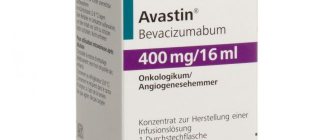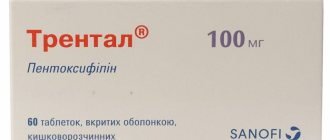Rezoklastin Concentrate, bottle, 1 piece, 6.25 ml, 5 mg, for solution for infusion
Pharmacological properties
Bone resorption inhibitor, nitrogen-containing bisphosphonate.
Acts primarily on bone, inhibits osteoclast activity and bone resorption. The selective effect of bisphosphonates on bone tissue is based on their high affinity for mineralized bone tissue. After IV administration, zoledronic acid is rapidly redistributed into the bones and, like other bisphosphonates, is localized primarily in areas of bone tissue remodeling.
The main molecular target of zoledronic acid in the osteoclast is the enzyme farnesyl pyrophosphate synthetase (FPS), although the possibility of other mechanisms of action cannot be excluded. The long period of action is determined by the high affinity for the active center of the FPS and pronounced affinity for mineralized bone tissue.
With the exception of its high antiresorptive effect, the effects of zoledronic acid on bone tissue are similar to those of other bisphosphonates.
In addition to its inhibitory effect on bone resorption, zoledronic acid has antitumor properties that provide therapeutic efficacy in bone metastases.
In vivo: inhibition of osteoclastic bone resorption, changing the microenvironment of the bone marrow, leading to a decrease in the growth of tumor cells; antiangiogenic activity. Suppression of bone resorption is clinically accompanied by a pronounced decrease in pain.
In vitro: inhibition of osteoblast proliferation, direct cytotoxic and proapoptotic activity, synergistic cytostatic effect with antitumor drugs; anti-adhesive/invasive activity.
Zoledronic acid, by inhibiting proliferation and inducing apoptosis, has a direct antitumor effect against human myeloma cells and breast cancer, and also reduces the penetration of breast cancer cells through the extracellular matrix, which indicates the presence of antimetastatic properties. In addition, zoledronic acid inhibits the proliferation of human endothelial cells and causes an antiangiogenic effect in animals.
In patients with tumor-induced hypercalcemia, zoledronic acid has been shown to act by decreasing serum calcium concentrations and decreasing urinary calcium excretion.
Pharmacokinetics
After the start of the infusion, the plasma concentration of zoledronic acid increases rapidly, reaching Cmax at the end of the infusion, followed by a rapid decrease in concentration by 10% after 4 hours and by less than 1% after 24 hours, with a successively prolonged period of low concentrations not exceeding 0.1% of the infusion. Cmax before re-infusion on day 28.
Zoledronic acid administered intravenously is excreted by the kidneys in 3 stages: rapid two-phase elimination from the systemic circulation with T1/2 of 0.24 hours and 1.87 hours and a long phase with a final T1/2 of 146 hours. No accumulation was noted with repeated administrations every 28 days.
Zoledronic acid does not undergo systemic metabolism and is excreted unchanged by the kidneys. During the first 24 hours, 39±16% of the administered dose is found in the urine. The remaining amount is mainly associated with bone tissue. Zoledronic acid is then slowly released back from bone tissue into the systemic circulation and excreted by the kidneys. The total plasma clearance is 5.04±2.5 l/h. Increasing the infusion time from 5 to 15 minutes resulted in a 30% decrease in zoledronic acid concentration at the end of the infusion but had no effect on AUC.
Less than 3% is excreted in feces.
Renal clearance of zoledronic acid is positively correlated with creatinine clearance.
Zoledronic acid has been shown to have a low affinity for blood components. Plasma protein binding is low (on average about 50%) and does not depend on the concentration of zoledronic acid.
Rezoclastin conc for preparation of solution inf 4mg/5ml
Active substance.
Zoledronic acid
Dosage form.
Concentrate for the preparation of solution for infusion.
Compound.
1 ml of concentrate contains: active substance: Zoledronic acid monohydrate - 0.85 mg (corresponds to anhydrous zoledronic acid) 0.80 mg; excipients: D-Mannitol - 44.0 mg, Sodium citrate dihydrate - 5.5 mg (corresponding to anhydrous sodium citrate) 4.8 mg, Water for injection up to 1.0 ml
1 bottle contains 5 ml (4 mg of zoledronic acid) or 6.25 ml (5 mg of zoledronic acid) concentrate.
Description.
The drug "Rezoklastin FS" belongs to a new class of highly effective bisphosphonates that have a selective effect on bone tissue. Zoledronic acid inhibits the activity of osteoclasts and does not have undesirable effects on the formation, mineralization and mechanical properties of bone tissue. The selective action of bisphosphonates on bone tissue is based on their high affinity for mineralized bone tissue, but the exact molecular mechanism that provides inhibition of osteoclast activity remains unclear. Zoledronic acid, in addition to its inhibitory effect on bone resorption, has direct antitumor properties that ensure effectiveness in bone metastases.
In vitro, it was found that zoledronic acid, by suppressing proliferation and inducing cell apoptosis, has a direct antitumor effect on myeloma and breast cancer cells and reduces the risk of their metastasis. Inhibition of osteoclastic bone resorption leads to a decrease in tumor cell growth; antiangiogenic and analgesic activity is noted. Zoledronic acid also inhibits the proliferation of human endothelial cells. With hypercalcemia caused by a tumor, it reduces the concentration of calcium in the blood serum.
When using zoledronic acid in patients with postmenopausal osteoporosis (T-criterion values for femoral neck bone mineral density less than 2.5), there was a statistically significant reduction in the risk of vertebral fractures, as well as a reduction in the risk of developing one or more new (recurrent) vertebral fractures. When treated with zoledronic acid in patients with Paget's disease of bone, a statistically significant, rapid and long-term therapeutic response, normalization of the level of bone turnover and the concentration of alkaline phosphatase in the blood plasma were observed.
The drug is also highly effective in patients previously treated with oral bisphosphonates. It has been established that in the majority of patients using zoledronic acid, the therapeutic response persists throughout the entire treatment period (about 2 years).
In patients with postmenopausal osteoporosis and Paget's disease of bone, zoledronic acid does not affect the qualitative state of normal bone, does not disrupt the processes of bone remodeling and mineralization, and promotes the preservation of normal trabecular bone architecture.
Indications.
- Hypercalcemia (albumin-corrected serum calcium concentration >12 mg/dL or 3 mmol/L) induced by malignant tumors.
- Metastatic bone disease from malignant solid tumors and myeloma (to reduce the risk of pathological fractures, spinal cord compression, tumor-related hypercalcemia, and reduce the need for radiation therapy).
- Postmenopausal form of primary osteoporosis.
- Senile form of primary osteoporosis.
- Secondary osteoporosis.
- Paget's disease of bone.
Rezoklastin FS
Rezoklastin FS is administered intravenously by drip for at least 15 minutes.
For hypercalcemia caused by malignant tumors (albumin-corrected calcium concentration >12 mg/dL or 3 mmol/L), the recommended dose of the drug is 4 mg, once. The infusion is carried out provided that the patient is adequately hydrated.
For metastatic bone lesions in malignant solid tumors and multiple myeloma, the recommended dose of the drug is 4 mg every 3-4 weeks. Additionally, it is recommended to prescribe oral calcium at a dose of 500 mg per day and vitamin D at a dose of 400 IU per day.
For postmenopausal and senile forms of primary osteoporosis, in order to increase bone mineral density, prevent fractures of vertebral bodies and other skeletal bones, the recommended dose of Rezoklastin FS is 5 mg, once a year.
For secondary osteoporosis, the recommended dose of Rezoklastin FS is 5 mg, once a year. If the intake of calcium and vitamin D from food is insufficient, patients with osteoporosis should be additionally prescribed calcium and vitamin D supplements. The duration of use of the drug is determined by the doctor individually depending on the patient’s condition.
For the treatment of Paget's disease of bone, a single intravenous administration of the drug at a dose of 5 mg is recommended. Since Paget's disease of bone is characterized by a high level of bone turnover, it is recommended that all patients with this disease take a daily dose of calcium and vitamin D for the first 10 days after administration of zoledronic acid.
Repeated treatment of Paget's disease of bone with zoledronic acid. After the first administration of the drug, a long period of remission is observed. Currently, there are no specific data on re-treatment of Paget's disease of bone. However, the possibility of repeated administration of the drug can be considered if a relapse of the disease is detected in patients based on the following criteria: lack of normalization of serum alkaline phosphatase activity, an increase in its activity over time, as well as the presence of clinical signs of Paget’s bone disease, detected during a medical examination after 12 months after the first dose of zoledronic acid.
In patients with impaired renal function
Hypercalcemia due to malignant tumors:
The decision to treat patients with severe renal impairment with zoledronic acid should only be made after a careful assessment of the risk/benefit ratio. If the serum creatinine concentration is <400 µmol/L or <4.5 mg/dL, no dosage adjustment is required.
Metastatic bone lesions in malignant solid tumors and multiple myeloma:
The dose of zoledronic acid in patients with impaired renal function depends on the initial level of creatinine clearance (CC), calculated using the Cockcroft-Gault formula. In case of severe renal impairment (creatinine clearance <30 ml/min), the use of zoledronic acid is not recommended. Recommended doses for mild or moderate renal impairment (creatinine clearance values 30-60 ml/min) are given below.
| Initial CS value (ml/min) | Recommended dose of zoledronic acid |
| 50-60 | 3.5 mg |
| 40-49 | 3.3 mg |
| 30-39 | 3.0 mg |
Serum creatinine concentrations should be determined before each dose of the drug. If renal dysfunction is detected, the next administration of zoledronic acid should be postponed. Renal dysfunction is determined by the following parameters:
- for patients with normal initial creatinine values (<1.4 mg/dl) - an increase in serum creatinine by 0.5 mg/dl;
- for patients with deviations in baseline creatinine levels (>1.4 mg/dL) - an increase in serum creatinine concentration by 1 mg/dL.
Therapy with zoledronic acid is resumed only after the creatinine concentration reaches values exceeding the initial value by no more than 10%, at the same dose that was used before interruption of treatment.
Instructions for preparing the solution
The solution is prepared under aseptic conditions. Before administration, the drug is diluted (the contents of 1 bottle is 4 mg / -5 ml or 5 mg / 6.25 ml, depending on the recommended dose) in 100 ml of solution for infusion that does not contain calcium (0.9% sodium chloride solution or 5% dextrose solution). It is advisable to use the prepared solution of Rezoklastin FS immediately after preparation. Unused solution can be stored in the refrigerator at a temperature of 2 to 8 ° C for no more than 24 hours. Before administration, the solution should be kept indoors until it reaches room temperature. The prepared zoledronic acid solution must be administered using a separate IV infusion system.
Osteostatix
Treatment of various types of osteoporosis, Paget's disease of bone, prevention of subsequent fractures in men and women with fractures of the proximal femur
With intravenous administration of 5 mg zoledronic acid once a year for the treatment of postmenopausal osteoporosis in women, osteoporosis in men, for the prevention of subsequent fractures in men and women with fractures of the proximal femur, for the prevention and treatment of osteoporosis caused by the use of glucocorticosteroids and for the treatment of bone disease Paget's disease, most adverse reactions (HP) were mild or moderate. After intravenous administration of zoledronic acid, the following adverse reactions (HP) were most often observed in these patients, usually lasting no more than 3 days (“post-dose” symptoms): fever (18.1%), myalgia (9.4%), influenza-like syndrome (7.8%), arthralgia (6.8%), headache (6.5%). Most of the above-mentioned HP observed within 3 days after drug administration were mild or moderate. With repeated administration of the drug, the frequency of adverse reactions decreased significantly.
The severity of post-infusion adverse events that develop within 3 days after the infusion can be reduced by using paracetamol or ibuprofen immediately after the infusion of the drug (see section "Special Instructions").
The following are adverse reactions associated (in the opinion of treating physicians) with the use of the drug for the treatment of various types of osteoporosis, Paget's disease of bone, the prevention of osteoporosis caused by the use of glucocorticosteroids, and for the prevention of new fractures in men and women with fractures of the proximal femur.
HP are grouped according to the MedDRA classification of organs and organ systems. Within each group of organs and organ systems, HPs are listed in order of decreasing frequency of occurrence. The following criteria were used to assess frequency: very often (≥1/10); often (≥1/100, <1/10); uncommon (≥1/1000, <1/100); rare (≥1/10000, <1/1000); very rare (<1/10000), including isolated reports.
Infectious and parasitic diseases: infrequently - influenza, nasopharyngitis.
Blood and lymphatic system disorders: uncommon - anemia.
Metabolic and nutritional disorders: uncommon - decreased appetite.
Mental disorders: infrequently - insomnia.
Nervous system disorders: often - headache, dizziness; uncommon - lethargy*, paresthesia, drowsiness, tremor, fainting
Visual disturbances: infrequently - conjunctivitis, eye pain; rarely - uveitis*, episcleritis, iritis.
Hearing and labyrinthine disorders: uncommon - vertigo.
Vascular disorders: uncommon - increased blood pressure, sudden redness of the face.
Disorders of the respiratory system, chest and mediastinal organs: infrequently - shortness of breath, cough*.
Digestive system disorders: often - nausea, vomiting, diarrhea; uncommon - dyspepsia*, pain in the upper abdomen, abdominal pain*, gastroesophageal reflux, constipation, dry mouth, esophagitis*.
Skin and subcutaneous tissue disorders: uncommon - skin rash, hyperhidrosis*, pruritus, erythema.
Musculoskeletal and connective tissue disorders: often - myalgia*, arthralgia*, bone pain, pain in the back and limbs; Uncommon: neck pain, muscle stiffness*, joint swelling*, muscle spasms, chest pain* of musculoskeletal origin, musculoskeletal pain, joint stiffness*, arthritis, muscle weakness.
Renal and urinary tract disorders: uncommon - increased concentration of creatinine in the blood, pollakiuria, proteinuria.
General disorders and disorders at the injection site: very often - fever; often - flu-like syndrome, chills, increased fatigue*, asthenia, pain*, general malaise; Uncommon: peripheral edema, thirst*, acute phase reactions*, non-cardiogenic chest pain.
* - In individual studies, the following HP were most often noted: very often - myalgia, arthralgia, fatigue, pain; often - lethargy, shortness of breath, dyspepsia, esophagitis, abdominal pain, hyperhidrosis, muscle stiffness, swelling in the joints, pain in the chest area of musculoskeletal origin, stiffness in the joints, decreased appetite, thirst, acute phase reactions; infrequently - uveitis.
In separate studies, HP was reported, the incidence of which was lower in the drug group than in patients receiving placebo.
Cardiac disorders: atrial fibrillation, palpitations.
Visual disturbances: redness of the eyes.
Digestive system disorders: gastritis (in patients receiving glucocorticosteroids), toothache.
General disorders and administration site disorders: administration site reactions.
Laboratory and instrumental data: increased concentration of C-reactive protein.
Metabolic and nutritional disorders: hypocalcemia.
Nervous system disorders: dysgeusia.
Prevention of postmenopausal osteoporosis
When using the drug Osteostatix for the prevention of postmenopausal osteoporosis (PMO), the overall safety profile of the drug was comparable to that in the treatment of PMO, with the exception of HP that occurred within 3 days after infusion: pain, fever, chills, myalgia, nausea, headache, increased fatigue, dizziness, arthralgia. the frequency of which was higher in patients receiving the drug to prevent PMO. Most of these HP were mild or moderate and resolved within 3 days of onset. With repeated administration of the drug, the incidence of HP data decreased significantly.
Below are the HP associated with the use of the drug for the prevention of PME (according to the attending physicians):
1) HP observed more than once with the administration of zoledronic acid for the prevention of PMO and not registered with the use of zoledronic acid for the treatment of various types of osteoporosis, Paget's disease of bone, the prevention of osteoporosis caused by the use of glucocorticosteroids, and for the prevention of new fractures in men and women with fractures of the proximal femur;
2) HP, the frequency of which was higher in women receiving the drug to prevent PMO (compared to other categories of patients).
The frequency of development of HP data was assessed as follows: very often (≥1/10); often (≥1/100, <1/10); uncommon (≥1/1,000, <1/100).
Metabolic and nutritional disorders: often - loss of appetite.
Mental disorders: infrequently - anxiety.
Nervous system disorders: very often - headache; often - tremor, lethargy; infrequently - hypoesthesia, dysgeusia.
Visual disturbances: often - conjunctivitis, eye pain, iritis; infrequently - blurred vision.
Disorders of the digestive system: very often - nausea; often - abdominal pain, pain in the upper abdomen, constipation.
Skin and subcutaneous tissue disorders: often - increased sweating at night.
Musculoskeletal and connective tissue disorders: very often - myalgia; often - musculoskeletal pain, muscle spasm, pain in the chest area of musculoskeletal origin, pain in the jaw area, pain in the neck area; infrequently - pain in the side.
General disorders and disorders at the injection site: very often - pain, chills; often - peripheral edema, reactions at the injection site, non-cardiogenic pain in the chest.
Description of selected adverse reactions
Renal dysfunction
With intravenous administration of bisphosphonates, including zoledronic acid, there have been cases of renal dysfunction with an increase in blood creatinine concentrations, and in rare cases, acute renal failure.
Impaired renal function after a single dose of zoledronic acid has been observed in patients with pre-existing renal impairment or in the presence of additional risk factors (for example, older age, cancer patients receiving chemotherapy, concomitant use of nephrotoxic or diuretic drugs, receiving the drug at a dose of 4 mg every 3-4 weeks.
However, in patients with impaired renal function or any of the above risk factors, renal failure requiring hemodialysis or leading to death was rare. Caution should be exercised when using the drug in patients with concomitant cancer diseases receiving chemotherapy due to the increased risk of developing renal failure.
When treated with zoledronic acid for 3 years in patients with postmenopausal osteoporosis, the incidence of increased plasma creatinine concentrations and the development of renal dysfunction and renal failure did not differ from that when using placebo. Patients receiving the drug were slightly more likely to experience a transient increase in creatinine concentrations within 10 days after infusion compared to placebo (1.8% and 0.8%, respectively).
When zoledronic acid was used for 2 years in men with osteoporosis, the incidence of changes in creatinine clearance and the development of renal dysfunction was similar to that in the alendronic acid group.
In patients with osteoporosis caused by the use of glucocorticosteroids, during therapy with zoledronic acid, the frequency of changes in creatinine clearance and the development of renal dysfunction was similar to that in the risedronic acid group.
When using the drug in patients with femoral fractures, the incidence of changes in creatinine clearance and the development of renal dysfunction was similar to that in the placebo group.
When using the drug in patients for the prevention of postmenopausal osteoporosis, the frequency of changes in creatinine clearance and the development of renal dysfunction was similar to that in the placebo group.
Hypocalcemia
In patients with postmenopausal osteoporosis, while using the drug, in 0.2% of cases there was a decrease in calcium content (<1.87 mmol/l) in the blood serum; no clinical signs of hypocalcemia were observed.
When using the drug in patients with femoral fractures, male osteoporosis and osteoporosis caused by taking glucocorticosteroids, there were no patients who required urgent therapy with a calcium concentration in the blood plasma <1.87 mmol/l.
When using the drug in patients for the prevention of postmenopausal osteoporosis, one patient required urgent therapy when the calcium level in the blood plasma was <1.87 mmol/l.
In patients with Paget's disease, in approximately 1% of cases, transient hypocalcemia was found, accompanied by clinical manifestations.
Reactions at the injection site
When using zoledronic acid in patients with postmenopausal osteoporosis, redness, swelling and/or pain at the injection site were observed in 0.7% of cases. In patients with femoral fractures, the incidence of local reactions was comparable to that in the placebo group.
In the treatment of osteoporosis in men, the incidence of injection site reactions was 2.6% (compared to 1.4% in the alendronic acid group).
In patients with osteoporosis caused by the use of glucocorticosteroids, no reactions were observed at the injection site.
When using the drug for the prevention of postmenopausal osteoporosis, the incidence of reactions at the injection site of zoledronic acid was 1.1% (compared to 2.0% in the placebo group).
Osteonecrosis of the jaw
Cases of osteonecrosis (most often osteonecrosis of the jaw) occurred mainly in patients with cancer receiving treatment with bisphosphonates (including zoledronic acid - infrequently), in most cases after tooth extraction or other dental procedures. Most patients had symptoms of a local infectious and inflammatory process, including osteomyelitis.
Known risk factors for osteonecrosis of the jaw include cancer, concomitant therapies (eg, chemotherapy, antiangiogenic drugs, radiotherapy, glucocorticosteroids), and comorbidities (eg, anemia, coagulopathies, infections, previous dental pathology). Although the cause-and-effect relationship of osteonecrosis of the jaw with the use of bisphosphonates has not been established, dental surgery should be avoided as recovery time after these operations may be increased {see. section "Special instructions"),
In clinical studies in patients with osteoporosis, osteonecrosis of the jaw occurred in 1 patient receiving zoledronic acid and 1 patient receiving placebo. In both cases, resolution of the process was noted.
When using zoledronic acid in patients with femoral fractures, with male osteoporosis and osteoporosis caused by taking glucocorticosteroids, as well as when using the drug for the prevention of postmenopausal osteoporosis, there were no cases of osteonecrosis of the jaw.
Atrial fibrillation
When using zoledronic acid in patients with postmenopausal osteoporosis, the overall incidence of atrial fibrillation during drug therapy was 2.5% (96 of 3862 people) compared with 1.9% (75 of 3852 people) in patients not treated with the drug ( placebo group). In 1.3% of patients (51 out of 3862) receiving zoledronic acid, and in 0.6% (22 out of 3852) in the placebo group, this adverse reaction was considered serious. The reason for the increased incidence of atrial fibrillation during zoledronic acid therapy was not determined in this study. The increased incidence of atrial fibrillation compared with placebo observed in this study was not found in other clinical studies of zoledronic acid.
Isolated reports of adverse reactions
During post-marketing studies, the following adverse reactions were identified (since the reports were obtained voluntarily from a population of unknown size, it is not possible to reliably determine the incidence of these HP developments, and therefore they are classified as frequency unknown).
HP are grouped according to the MedDRA classification of organs and organ systems. Within each group of organs and organ systems, HPs are listed in order of decreasing severity.
Violation of the organ of vision: scleritis, inflammation of the periorbital tissues.
Immune system disorders: hypersensitivity reactions, including anaphylactic reaction, anaphylactic shock, angioedema, bronchospasm, urticaria.
Metabolic and nutritional disorders: dehydration (developing as a result of post-infusion phenomena such as fever, vomiting and diarrhea), hypophosphatemia.
Vascular disorders: marked decrease in blood pressure (in patients with risk factors).
Musculoskeletal and connective tissue disorders: osteonecrosis of the jaw.
Renal and urinary tract disorders: Renal impairment, including renal failure requiring hemodialysis or death*
*especially in patients with a history of either renal pathology or additional risk factors (for example, advanced age, concomitant therapy with nephrotoxic drugs, diuretics or severe dehydration).
If any of the side effects indicated in the instructions get worse, or you notice any other side effects not listed in the instructions, tell your doctor.



